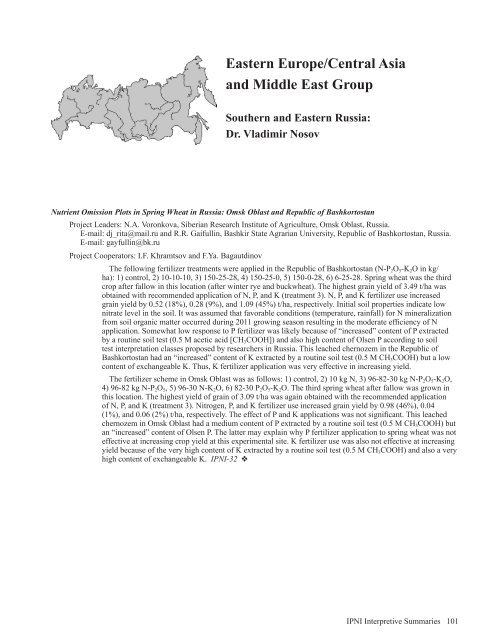Americas and Oceania Group - International Plant Nutrition Institute
Americas and Oceania Group - International Plant Nutrition Institute
Americas and Oceania Group - International Plant Nutrition Institute
You also want an ePaper? Increase the reach of your titles
YUMPU automatically turns print PDFs into web optimized ePapers that Google loves.
Eastern Europe/Central Asia<br />
<strong>and</strong> Middle East <strong>Group</strong><br />
Southern <strong>and</strong> Eastern Russia:<br />
Dr. Vladimir Nosov<br />
Nutrient Omission Plots in Spring Wheat in Russia: Omsk Oblast <strong>and</strong> Republic of Bashkortostan<br />
Project Leaders: N.A. Voronkova, Siberian Research <strong>Institute</strong> of Agriculture, Omsk Oblast, Russia.<br />
E-mail: dj_rita@mail.ru <strong>and</strong> R.R. Gaifullin, Bashkir State Agrarian University, Republic of Bashkortostan, Russia.<br />
E-mail: gayfullin@bk.ru<br />
Project Cooperators: I.F. Khramtsov <strong>and</strong> F.Ya. Bagautdinov<br />
The following fertilizer treatments were applied in the Republic of Bashkortostan (N-P 2 O 5 -K 2 O in kg/<br />
ha): 1) control, 2) 10-10-10, 3) 150-25-28, 4) 150-25-0, 5) 150-0-28, 6) 6-25-28. Spring wheat was the third<br />
crop after fallow in this location (after winter rye <strong>and</strong> buckwheat). The highest grain yield of 3.49 t/ha was<br />
obtained with recommended application of N, P, <strong>and</strong> K (treatment 3). N, P, <strong>and</strong> K fertilizer use increased<br />
grain yield by 0.52 (18%), 0.28 (9%), <strong>and</strong> 1.09 (45%) t/ha, respectively. Initial soil properties indicate low<br />
nitrate level in the soil. It was assumed that favorable conditions (temperature, rainfall) for N mineralization<br />
from soil organic matter occurred during 2011 growing season resulting in the moderate efficiency of N<br />
application. Somewhat low response to P fertilizer was likely because of “increased” content of P extracted<br />
by a routine soil test (0.5 M acetic acid [CH 3 COOH]) <strong>and</strong> also high content of Olsen P according to soil<br />
test interpretation classes proposed by researchers in Russia. This leached chernozem in the Republic of<br />
Bashkortostan had an “increased” content of K extracted by a routine soil test (0.5 M CH 3 COOH) but a low<br />
content of exchangeable K. Thus, K fertilizer application was very effective in increasing yield.<br />
The fertilizer scheme in Omsk Oblast was as follows: 1) control, 2) 10 kg N, 3) 96-82-30 kg N-P 2 O 5 -K 2 O,<br />
4) 96-82 kg N-P 2 O 5 , 5) 96-30 N-K 2 O, 6) 82-30 P 2 O 5 -K 2 O. The third spring wheat after fallow was grown in<br />
this location. The highest yield of grain of 3.09 t/ha was again obtained with the recommended application<br />
of N, P, <strong>and</strong> K (treatment 3). Nitrogen, P, <strong>and</strong> K fertilizer use increased grain yield by 0.98 (46%), 0.04<br />
(1%), <strong>and</strong> 0.06 (2%) t/ha, respectively. The effect of P <strong>and</strong> K applications was not significant. This leached<br />
chernozem in Omsk Oblast had a medium content of P extracted by a routine soil test (0.5 M CH 3 COOH) but<br />
an “increased” content of Olsen P. The latter may explain why P fertilizer application to spring wheat was not<br />
effective at increasing crop yield at this experimental site. K fertilizer use was also not effective at increasing<br />
yield because of the very high content of K extracted by a routine soil test (0.5 M CH 3 COOH) <strong>and</strong> also a very<br />
high content of exchangeable K. IPNI-32 v<br />
IPNI Interpretive Summaries 101

















